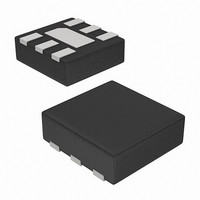ISL29020IROZ-T7A Intersil, ISL29020IROZ-T7A Datasheet - Page 3

ISL29020IROZ-T7A
Manufacturer Part Number
ISL29020IROZ-T7A
Description
IC SENSOR LIGHT-DGTL I2C 6ODFN
Manufacturer
Intersil
Datasheet
1.ISL29020IROZ-EVALZ.pdf
(11 pages)
Specifications of ISL29020IROZ-T7A
Lead Free Status / RoHS Status
Lead free / RoHS Compliant
Pin Descriptions
Principles of Operation
Photodiodes and ADC
The ISL29020 contains two photodiode arrays which convert
light into current. The spectral response for ambient light
sensing and IR sensing is shown in Figure 8 in the “Typical
Performance Curves” on page 9. After light is converted to
current during the light signal process, the current output is
converted to digital by a single built-in 16-bit Analog-to-Digital
Converter (ADC). An I
IR intensity in counts.
The converter is a charge-balancing integrating type 16-bit
ADC. The chosen method for conversion is best for converting
small current signals in the presence of an AC periodic noise. A
100ms integration time, for instance, highly rejects 50Hz and
60Hz power line noise simultaneously. See “Integration Time or
Conversion Time” on page 6 and “Noise Rejection” on page 7.
The built-in ADC offers user flexibility in integration time or
conversion time. There are two timing modes: Internal Timing
Mode and External Timing Mode. In Internal Timing Mode,
integration time is determined by an internal oscillator (f
and the n-bit (n = 4, 8, 12,16) counter inside the ADC. In
External Timing Mode, integration time is determined by the
time between two consecutive I
commands. See “External Timing Mode” on page 6. A good
balancing act of integration time and resolution depending on
the application is required for optimal results.
The ADC has I
accommodate various lighting conditions. For very dim
conditions, the ADC can be configured at its lower range
(Range 1). For bright conditions, the ADC can be configured
at its higher range (Range 2).
I
There are three 8-bit registers available inside the ISL29020.
The command register defines the operation of the device.
The command register does not change until the register is
overwritten. The two data registers are Read-Only for 16-bit
ADC output or timer output. The data registers contain the
ADC's or timer’s latest digital output.
The ISL29020’s I
as 1000100 or 1000101 by connecting A0 pin to GND or
VDD, respectively. When 1000100x or 1000101x with x as R
or W is sent after the Start condition, this device compares
the first seven bits of this byte to its address and matches.
2
PIN NUMBER
C Interface
1
2
3
4
5
6
2
C programmable ranges to dynamically
2
C interface slave address can be selected
PIN NAME
2
REXT
C command reads the ambient light or
GND
VDD
SCL
SDA
A
0
3
2
C External Timing Mode
Positive supply; connect this pin to a 2.25V to 3.3V supply.
Ground pin.
External resistor pin for ADC reference; connect this pin to ground through a (nominal) 500kΩ resistor.
Bit 0 of I
I
I
2
2
C serial clock
C serial data
2
C address; ground or tie this pin to VDD. No floating.
OSC
),
ISL29020
The I
Figure 1 shows a sample one-byte read. Figure 2 shows a
sample one-byte write. Figure 3 shows a sync_I
diagram sample for externally controlled integration time. The
I
the master or the slave can drive the SDA (data) line. Every
I
condition (SDA falling while SCL remains high). The following
byte is driven by the master, and includes the slave address
and read/write bit. The receiving device is responsible for
pulling SDA low during the acknowledgement period. Every
I
condition (SDA rising while SCL remains high).
For more information about the I
the Philips
Low-Power Operation
The ISL29020 initial operation is at the power-down mode
after a supply voltage is provided. The data registers contain
the default value of 0. When the ISL29020 receives an I
command to do a one-time measurement from an I
master, it will start light sensing and ADC conversion. It will
go to the power-down mode automatically after one
conversion is finished and keep the conversion data
available for the master to fetch anytime afterwards. The
ISL29020 will continuously do light sensing and ADC
conversion if it receives an I
measurement. It will continuously update the data registers
with the latest conversion data. It will go to the power-down
mode after it receives the I
2
2
2
C bus master always drives the SCL (clock) line, while either
C transaction begins with the master asserting a start
C transaction ends with the master asserting a stop
2
C bus lines can be pulled from 1.7V to above V
DESCRIPTION
®
I
2
C specification documents.
2
C command of power-down.
2
C command of continuous
2
C standard, please consult
DD
2
C timing
, 3.6V max.
August 20, 2009
2
C
FN6505.1
2
C











